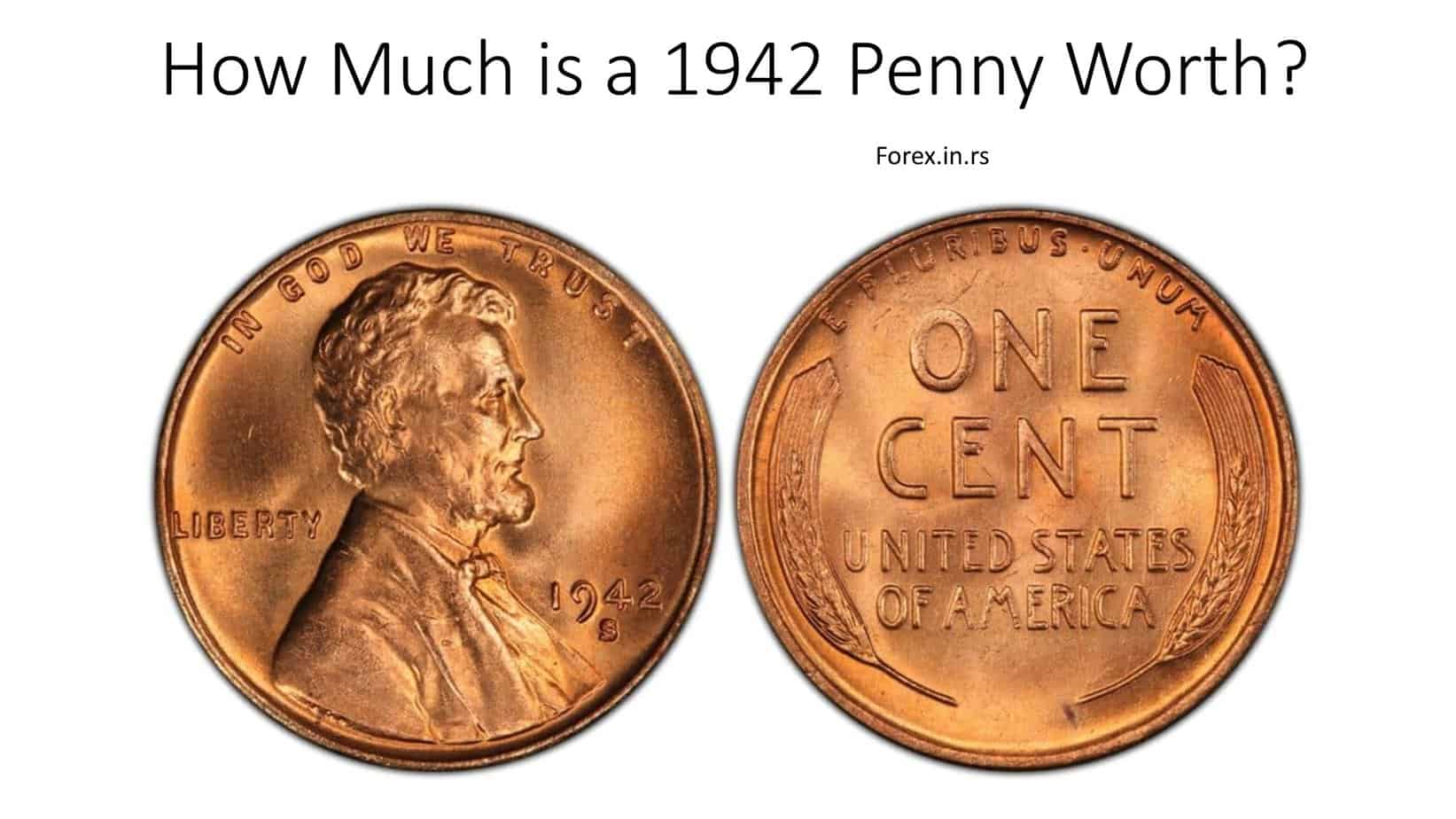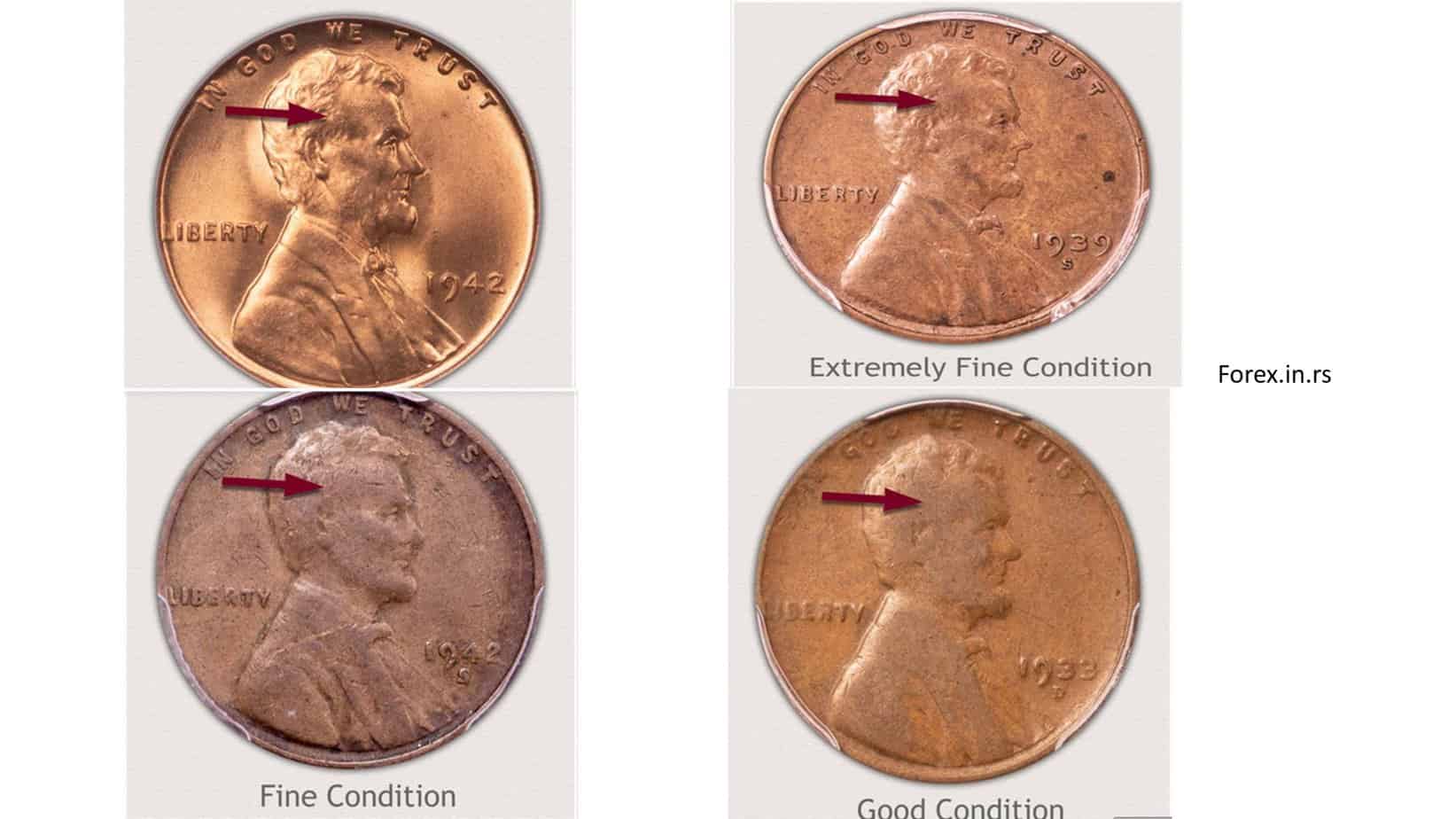Table of Contents
The value of coins constantly fluctuates, so it’s essential to stay informed about what your collection may be worth. If you’ve got a 1942 Lincoln penny, you have a piece of history in your hands. Recently we wrote an article about 1964. penny worth (rare 1964. penny is worth up to $15600 ). This article will explore how much a 1942 penny is worth and the factors that can affect its value.
How Much is a 1942 Penny Worth?
Generally, a regular 1942 Lincoln penny (from the Denver Mint or Philadelphia Mint) is worth around 15 to 20 cents. However, this value can change depending on its condition. A good coin would fetch more than 20 cents, while one in acceptable condition could be worth up to 50 cents. An excellent 1942 Lincoln penny could be worth as much as 75 cents, while an uncirculated specimen from either mint could be worth up to $5.50!

1942 Penny characteristics:
- Denomination: $0.01
- Designer: Victor David Brenner
- Diameter: 19 mm
- Main Reverse Feature: Wheat stalks
- Mass / Weight: 3.11 grams
- Metal Composition: 95% copper and 5% (tin/zinc)
- 1942 penny Mint: Philadelphia, Denver, San Francisco
- Mintage Number: 864,579,590 coins
- Name of Coin: 1942 Wheat Penny
- Pawnshop Value: $0.15-$5.5
- Portrait: Abraham Lincoln
- Series of coins: 1942, 1942 D, 1942 S, Proofs
Please see the Table below to compare prices:
1942 Penny Worth Table
| Penny year | Good shape | Fine shape | Extremly fine shape | UNCIRCULATED penny |
|---|---|---|---|---|
| 1942 Lincoln Penny | $0.15 | $0.20 | $0.50 | $0.75 |
| 1942 Lincoln Penny (D) | $0.15 | $0.20 | $0.50 | $0.85 to $1.25 |
| 1942 Lincoln Penny (S) | $0.20 | $0.30 | $1.25 | $5 up to $6. |
As shown in the Table above, the 1942 penny can be uncirculated, extremely fine, fine, good. Uncirculated 1942 Penny, worth the most. The condition of the coin determines Penny’s worth. Coins that have not been circulated or have only gone through minimal circulation are considered to be of higher value and grade. When grading a penny’s worth, it is essential to evaluate the coin’s condition from its visual appearance, raised lettering, and imagery. It is also important to note that coins that have been heavily circulated may appear scratched, dented, or otherwise damaged and will be valued lower than coins in pristine condition.
- Uncirculated: A coin that has never spent any time exchanging hands is considered un-circulated or uncirculated. Because these coins were never used, their condition has been well-preserved such that the raised lettering and imagery will remain flawless. Uncirculated coins are valued highly due to their rarity and perfect condition.
- Extremely Fine: A coin determined to be of Extremely Fine grade will look mostly pristine but may feature one or two minor flaws. These flaws are small and not easily noticeable by the naked eye, but they still need to be considered when assessing the coin’s overall value. An Extremely Fine graded penny is worth more than one in Fine condition but less than an Uncirculated piece.
- Fine: A coin of Fine grade has likely been circulated but has managed to avoid any heavy damage, such as scratches, dents, etc. However, these coins may still show signs of wear and tear resulting from circulation, which can affect their overall value. It’s essential to consider these minor signs when grading an acceptable penny to assess its actual value accurately.
- Very Good: A good-rated penny will likely have some heavy wear from being in circulation for some time; however, it should still retain most of its details, including legibility on raised lettering/imagery. Due to this wear, Very Good graded pennies can generally fetch lower prices than those with higher grades, such as Extremely Fine or Uncirculated pieces.
- Good: Good-graded pennies typically show significant signs of wear, resulting in a loss in detail visually and on raised lettering/imagery on the coin itself. Furthermore, many Good graded coins may also have blemishes from prior handling or cleaning, which can further reduce their value relative to other graded pennies with fewer flaws/damage.

Poor: Poor-graded pennies usually show significant wear resulting from prolonged circulation and are subject to heavy handling over time, resulting in substantial damage, often making them almost unrecognizable compared with other grades such as Very Good or Extremely Fine pieces. Poorly graded pieces are usually sold at lower values relative to different grades due mainly to the lack of any remaining detail present on them both visually or even raised lettering/imagery-wise, making them almost unidentifiable without proper examination under lighting conditions suitable for adequate evaluation purposes.
1942 Penny rarity
A significant factor that affects the value of any coin is a rarity. The Denver mint produced significantly fewer pennies than their Philidelphia counterpart in 1942 – making the “D” variety rare and, like this, more valuable than the regular issue coinage from Philly. For example, a 1942 Lincoln penny with the “D” mint mark typically fetches around 20-30 cents if it is in fine condition and up to 80 cents to $1.25 if it is in excellent condition – whereas regular issues from Philadelphia are only marginally more valuable at 25-30 cents depending on their state of preservation.
It’s also important to consider how well-preserved your coin is before you attempt to sell or trade it for other coins/collectibles/etc. Coins showing signs of wear, such as scratches or discoloration, are often worth less than comparable coins with no signs of damage or wear-and-tear. Therefore, if you’re looking for top dollar for your 1942 Lincoln penny, it might be wise to invest some time into restoring its natural luster before trying to sell it off!
Finally, another factor that can impact a vintage coins’ price tag is its market demand – which can vary drastically depending on economic conditions at any given time and overall collector sentiment towards certain types of coins or styles of collecting itself!
Determining the exact value of any single coin (especially those made before 1965) can be tricky since there are so many variables at play when pricing vintage specimens like the 1942 Lincoln Penny! However, considering all the factors mentioned above, you should have a better idea of where your piece fits within the grand scheme of coin collecting and numismatic history!
1942. Penny Design History
The Lincoln Penny, first introduced in 1909 after President Theodore Roosevelt’s push to improve the aesthetic of American coinage, has been a reminder of the legacy of President Abraham Lincoln since its inception. The original design featured a portrait of Lincoln on the obverse side with two wheat stalks flanking it. On the reverse was an adaptation of the Lincoln Memorial.
For decades, the penny kept this iconic design that had come to signify patriotism and national pride. But with the onset of World War II, this all changed in 1942 when the mint needed to begin producing pennies with no metal content due to the need for brass and other metals for wartime production. This resulted in the introduction of what became known as a “steel penny” or “war penny” – a design markedly different from any previous coin.
The steel penny featured a reverse side featuring a single large wheat stalk instead of two smaller ones. This new design also removed Lincoln’s image from both sides. It replaced it with a picture of Lady Liberty wearing a Phrygian cap, which was chosen as a nod to America’s struggle against fascism during WWII. The obverse side also included an inscription reading “In God We Trust” – another symbol of Americans’ resolve in those trying times.
Despite being met with some initial confusion due to their radically different design, these steel pennies eventually gained popularity amongst Americans due to their connection to wartime patriotism and spirit as well as their unique appearance. They were only produced for one year in 1942 before being replaced by copper-plated zinc coins in 1943; however, they remain popular today amongst collectors due to their historical significance and scarcity.
Aside from its role in commemorating one of America’s most historical wars, the steel penny is an important reminder of how drastically our lives can change overnight – something we can all relate to today more than ever before. In times like these, many find solace in looking back at our past successes and remembering how even during our darkest hours, we have always managed to prevail and come out stronger on the other side – just like we did during WWII when steel pennies found their way into circulation here at home while battles raged overseas.
Conclusion
In conclusion, the worth of a 1942 Lincoln penny depends heavily on its condition – from around 20 cents to as much as $5.50 (uncirculated 1942. penny). A well-cared-for example can still fetch quite a bit more than one in poor condition, and uncirculated or minted coins in specific locations like Denver and Philadelphia may be worth even more. Collectors often search for these coins due to their rarity and historical value, so if you own one, it could be worth significantly more than its face value. It’s worth taking the time to research your coin’s condition and determine its true worth!
If you like bills and coins, you should learn more about Gold and Silver IRAs. You can protect your retirement fund if you invest in precious metals. Investors with gold IRAs can hold physical metals such as bullion or coins. Get a free pdf about Gold IRA.
GET GOLD IRA GUIDE
























